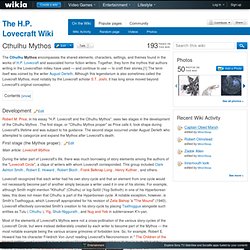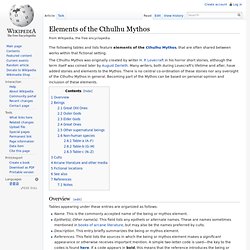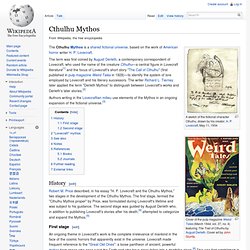

Creator/H.P. Lovecraft. Emerald.pdf. Cthulhu Mythos - The H.P. Lovecraft Wiki. The Cthulhu Mythos encompasses the shared elements, characters, settings, and themes found in the works of H.P.

Lovecraft and associated horror fiction writers. Together, they form the mythos that authors writing in the Lovecraftian milieu have used — and continue to use — to craft their stories.[1] The term itself was coined by the writer August Derleth. Although this legendarium is also sometimes called the Lovecraft Mythos, most notably by the Lovecraft scholar S.T. Joshi, it has long since moved beyond Lovecraft's original conception. Development Edit Robert M. First stage (the Mythos proper): Edit Main article: Lovecraft Mythos During the latter part of Lovecraft's life, there was much borrowing of story elements among the authors of the "Lovecraft Circle", a clique of writers with whom Lovecraft corresponded. The Mythos as a background element Edit According to David E. Second stage (the "Derleth Mythos") Third Stage Structure Theme Derleth's involvement Elemental theory Conclusion Fundament.
Elements of the Cthulhu Mythos. The following tables and lists feature elements of the Cthulhu Mythos, that are often shared between works within that fictional setting.

The Cthulhu Mythos was originally created by writer H. P. Lovecraft in his horror short stories, although the term itself was coined later by August Derleth. Many writers, both during Lovecraft's lifetime and after, have added stories and elements to the Mythos. There is no central co-ordination of these stories nor any oversight of the Cthulhu Mythos in general. Overview[edit] Tables appearing under these entries are organized as follows:
Necronomicon. H.P. Lovecraft: Fear Of The Unknown [2008] Lovecraft-bestiary.jpg (JPEG Image, 1280 × 1792 pixels) - Scaled (55%) Cthulhu Mythos. A sketch of the fictional character Cthulhu, drawn by his creator, H.

P. Lovecraft, May 11, 1934 The Cthulhu Mythos is a shared fictional universe, based on the work of American horror writer H. P. Lovecraft. The term was first coined by August Derleth, a contemporary correspondent of Lovecraft, who used the name of the creature Cthulhu—a central figure in Lovecraft literature[1] and the focus of Lovecraft's short story "The Call of Cthulhu" (first published in pulp magazine Weird Tales in 1928)—to identify the system of lore employed by Lovecraft and his literary successors. Authors writing in the Lovecraftian milieu use elements of the Mythos in an ongoing expansion of the fictional universe.[3] History[edit] Robert M. First stage[edit] An ongoing theme in Lovecraft's work is the complete irrelevance of mankind in the face of the cosmic horrors that apparently exist in the universe. There have been attempts at categorizing this fictional group of beings, and Phillip A. R'lyeh. The location of R'Lyeh given by Lovecraft was 47°9′S 126°43′W in the southern Pacific Ocean.

August Derleth placed it at 49°51′S 128°34′W. Both locations are close to the Pacific pole of inaccessibility or "Nemo" point, 48°52.6′S 123°23.6′W, a point in the ocean farthest from any land mass. The nightmare corpse-city of R'lyeh…was built in measureless eons behind history by the vast, loathsome shapes that seeped down from the dark stars. There lay great Cthulhu and his hordes, hidden in green slimy vaults. R'lyeh is characterized by bizarre architecture likened to non-Euclidean geometry. Lovecraft claims R'lyeh is located at WikiMiniAtlas 47°9′S 126°43′W / 47.150°S 126.717°W / -47.150; -126.717 (R'lyeh fictional location (Lovecraft))Coordinates: 48°52.6′S 123°23.6′W / 48.8767°S 123.3933°W / -48.8767; -123.3933 (Oceanic Pole of Inaccessibility)), a point in the ocean farthest from any land mass.
See also[edit] Bloop Notes[edit] ^ Jump up to: a b c H. References[edit] External links[edit]